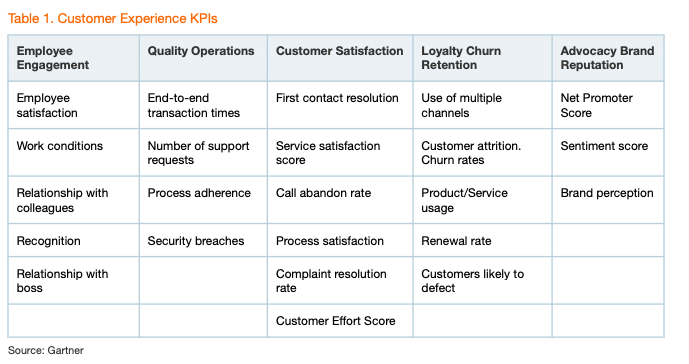
Customer Experience Isn't a Guessing Game: Get 5 Actionable Methods and the Customer Service KPI Categories You Need to Put Your Data to Work for an Off-The-Chart CX
Research out of the University of Texas found that increasing data’s usability by only 10% would cause an average revenue boost of $2 billion for Fortune 1000 companies.
We’ve been conditioned to understand that intelligent analytics give us a clear view of what’s happening with our business. At this point in your contact center’s history, some 51% of contact centers have even realized data needs to be actionable for the specific agents and leaders who need it.
There’s a missing piece in the years of buildup and constant chatter about the importance of data and metrics down to every last customer service KPI, though.
Collecting and viewing your data doesn’t mean you’ll magically improve your CX. Your work isn’t over after you carefully harvest info from your customer and agent interactions. The hard (and important) work lives in how you act on what you find. It lives in how you use your insights to fuel positive changes that improve your customer and agent experience.
Your data is a powerhouse of information that lets you spot operational inefficiencies, agent empowerment issues, or inaccuracies that make your customer interactions difficult.
It’s time to use it.
We’re here to help. We’re digging into five categories of metrics Gartner identified in their Future of Customer Service Analytics Report as the customer experience KPIs to watch. And, we’re dishing out tactics and strategies to put the data to use for a better CX.

1. Employee Engagement
Here, we step beyond employee engagement and look at this category as your agents’ holistic experience.
You can have dozens of “actionable” KPIs, but if you don’t have two eyes on your agent experience, you’ll never improve customer service.
Looking to the future, 40% of contact centers think they need to measure agent effort, like how long it takes an agent to find customer information, in the next year.
Be introspective about your agents’ environment. Examine the tools they have, look at metrics and surveys on their satisfaction, engagement, relationships with peers (and with you). View your performance and employee sentiment metrics side-by-side to see an agent’s unique efficiency, effectiveness, and empowerment for a view of their holistic well-being.
What to do with the information you find:
Use the survey data and measurements we talked on above to see where agents struggle. Map out what metrics they’re missing and where they’re excelling during interactions. Then, eliminate specific pain points in their experience and coach for empowerment.
Start by sharing agent-specific metrics with each agent for better performance management and employee development. Your agents don’t have the time (or, usually, access) to dig through dozens of cells seeking the metrics that matter to them. And, they certainly don’t have time to dig around for customer information, either.
Create dashboards that map out your agents’ most crucial KPIs, so they can see how they’re doing at a glance. Walk them through the metrics and why they matter. Tailor their coaching and in-line training to address issues specific to each agent. Then, connect your systems to empower agents with complete customer data and interaction history, so they can problem-solve on their own.
According to contact center leaders, empowering an agent to offer custom or unique resolutions to customers has the biggest impact on a positive experience. When agents know how they’re tracking towards goals, they can shift mid-course to offer customers better outcomes.
2. Quality Operations
We like to think of this category as quality assurance (QA).
Pay close attention to specific metrics and data points related to your quality operations. Think about some of your key efficiency metrics, (like, average handle time and average speed of answer), policies, procedures, and security, here.
Ask yourself: Are agents sticking to internal processes and procedures (with wiggle room, of course)? Do they understand what’s expected in terms of quality? Along the same lines, do they understand why it’s expected? Keep a close watch on quality metrics and your contact center’s outlined best practices to make sure every service interaction meets customer expectations.
What to do with the information you find:
Update your policies and documentation to better serve your agents. And, get specific with your agent coaching and training. Did you find that average handle times are sky-high because agents spend too much time searching for information? Or, are agents out of their queues too long because they’re overburdened and need a breather?
Dig into the specific data points and look for common trends and patterns to address. Remember, just because an agent misses a metric doesn’t mean they didn’t give it their best shot. Their handle times could’ve spiked because they didn’t have the right resources readily accessible.
Look at the systems and processes you have in place. See how you can help your team work more efficiently. Speed up your average speed of answer by rerouting overflow calls to different sets of agents, and make sure your skills-based routing is working for you, not against you.
Use your numbers as a guide to diagnose key problems with quality in your contact center. Then, if need be, address the root cause with specific and actionable coaching, better resources for your team, and processes that are easier to understand.
3. Customer Satisfaction
How happy or unhappy are your customers on an interaction-by-interaction basis? Are they satisfied with the service your agents and your company provide? Or, do you need to do better?
Monitor metrics related to your customers’ happiness, like CSAT, Customer Effort Score, and FCR to get insight into how your company’s doing on the service front. Then, dive into your call transcriptions and recordings to see what customers say (and how they feel) in-the-moment, too.
What to do with the information you find:
Equipped with data and interaction history, ID key customer concerns and plot a path to fix them.
Coach your agents to improve all service interactions. Serve up relevant micro-learning lessons based on customer comments. If all your one-star reviews were written by customers who waited on hold for 30 minutes, then coach agents to jump on the phones quicker. Or, see what held them back from taking more interactions. Maybe absenteeism was up that day, or you had an outage that sent agents into interaction overload. Then, work to improve your WFM strategy or work cross-functionally to keep customers in-the-know about important status updates.
Ready to progress your contact center even further? Take an advanced approach with sentiment analysis. Monitor calls and interactions for customer sentiment. And, set up thresholds and triggers for call reviews and coaching opportunities based on the sentiment you get back. Learn more.
4. Loyalty, Churn, Retention
When using data to inform decisions in your contact center, it’s important to think long-term about how data impacts your entire experience strategy, too. What’s your average Customer Lifetime Value? And, what key factors impact that lifetime value?
Look to specific metrics like Customer Churn and Renewal Rate to see how many of your customers jump ship (and why). Measure product and service usage/adoption to see where your customers find the most value from what you offer and where they need a little nudge.
What to do with the information you find:
Analyze your data for trends on why customers leave (and why they stay).
Build loyalty dashboards to watch your metrics side-by-side and get a view of your customers’ journey with your company. What customers have been with your company the longest? What products and services do they use? How often do they reach out for help? What channels do they use to contact you? Which agents do they interact with?
Spot trends and patterns that could’ve impacted their decision to stay with your company. And, do the opposite for customers who churned. What was their tipping point? How can you help your agents improve the outcome for next time? Or, how can you communicate key product or company issues back to company leaders?
It’s not your agents’ fault if a customer isn’t happy with a product.
“Take your contact center metrics seriously, not just in terms of agent performance but as indicators of what might be a broken customer journey. Blaming agents for customers who are unsatisfied with, say, a faulty product or overly strict return policy doesn’t solve the problem.” – Kindra Cooper, CCW Digital
However, you and your team are in a unique position to influence customer loyalty. Even when a customer is frustrated with your company, not with their service experience.
Some 86% of customers said if they built an emotional connection with a customer service agent, they’d be willing to continue doing business. If you see service interactions spike for customers who end up sticking around, review a handful of those interactions to see how agents built connections to keep them. Then, work with your team to repeat those moments, every time.
Need some more advice to reduce customer churn? Find 7 Fail-Proof Methods to Reduce Customer Churn over here.
5. Advocacy, Brand Reputation
It’s hard to find a better team morale booster than positive customer outcomes. And, it’s even harder to find more honest feedback than what you get back from your brand advocates.
Keep an eye on metrics like Net Promoter Score and Sentiment Score. And, gather contextual proof on brand perception from your service interaction. You’ll learn who promotes your business without being asked and who sings the praises of your service team.
What to do with the information you find:
See what customers actively chatter about your business on review sites and who shares praise after their service interactions. Then, nurture these customers further. Flag them as high-priority in your systems and coach agents to hand out goodwill gestures (like a check-in email or a proactive message) when they see fit.
Lean into your promoters. Work with your VP of Ops and other department heads to build up these important relationships. Ask them to be a resource for your team in exchange for early access to new products or services. Float the idea to bring these customers in town for a customer focus group. See what they love and what could be better. This group of customers is more likely to share authentic feedback about their service experiences and overall customer experience.
Use what you find from these promoters to create templates for better service experiences. Target your brand detractors with methods your advocates loved to flip the script.
You have a wealth of data and knowledge at your fingertips. Use these tactics to put it to work to fix your contact center’s most pertinent problems.

